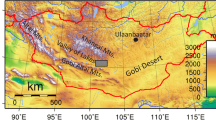Abstract.
The sediment stratigraphy of a medium-sized mixotrophic lake (Ruila) situated below the highest shoreline of the Baltic Ice Lake in the West-Estonian Lowland is described. The lake is without natural inlets our outlets. The reconstruction of vegetation and land-use history based on pollen data, combined with available archaeological data and detailed 14C dating allows us to give a provisional reconstruction of the temporal and spatial pattern of natural and human induced environmental changes in north-west Estonia during the Holocene. Both radiocarbon dates derived from terrestrial macrofossil dating by accelerator mass spectrometry (AMS) and conventional dating of bulk lake sediment are discussed. The isolation of the lake basin from the Yoldia Sea took place ca. 9700 cal B. C. The Ancylus Lake transgression at ca. 8400 cal B. C. did not reach the basin, but caused a ground water rise, seen in the sediment stratigraphy of the lake. The first signs of human impact on the pollen record appear ca. 5400 cal B. C. (Late Mesolithic). The history of arable farming has been divided into three periods: 1) introduction of crop cultivation and animal husbandry (1500 cal B. C. – A. D. 500); 2) establishment of animal husbandry A. D. 500–1000) and 3) establishment of crop cultivation and intensive cattle breeding (A. D. 1000–today). Due to unfavourable eda-phic conditions the introduction of arable farming was delayed for more than 1000 years compared with elsewhere on the north coast of Esotnia, and intensity of land-use never reached the same proportion as in these areas.
Similar content being viewed by others
Author information
Authors and Affiliations
Additional information
Received August 15, 2001 / Accepted August 5, 2002
Correspondence to: Leili Saarse
Rights and permissions
About this article
Cite this article
Poska, A., Saarse, L. Biostratigraphy and 14C dating of a lake sediment sequence on the north-west Estonian carbonaceous plateau, interpreted in terms of human impact in the surroundings. Veget Hist Archaeobot 11, 191–200 (2002). https://doi.org/10.1007/s003340200022
Issue Date:
DOI: https://doi.org/10.1007/s003340200022




